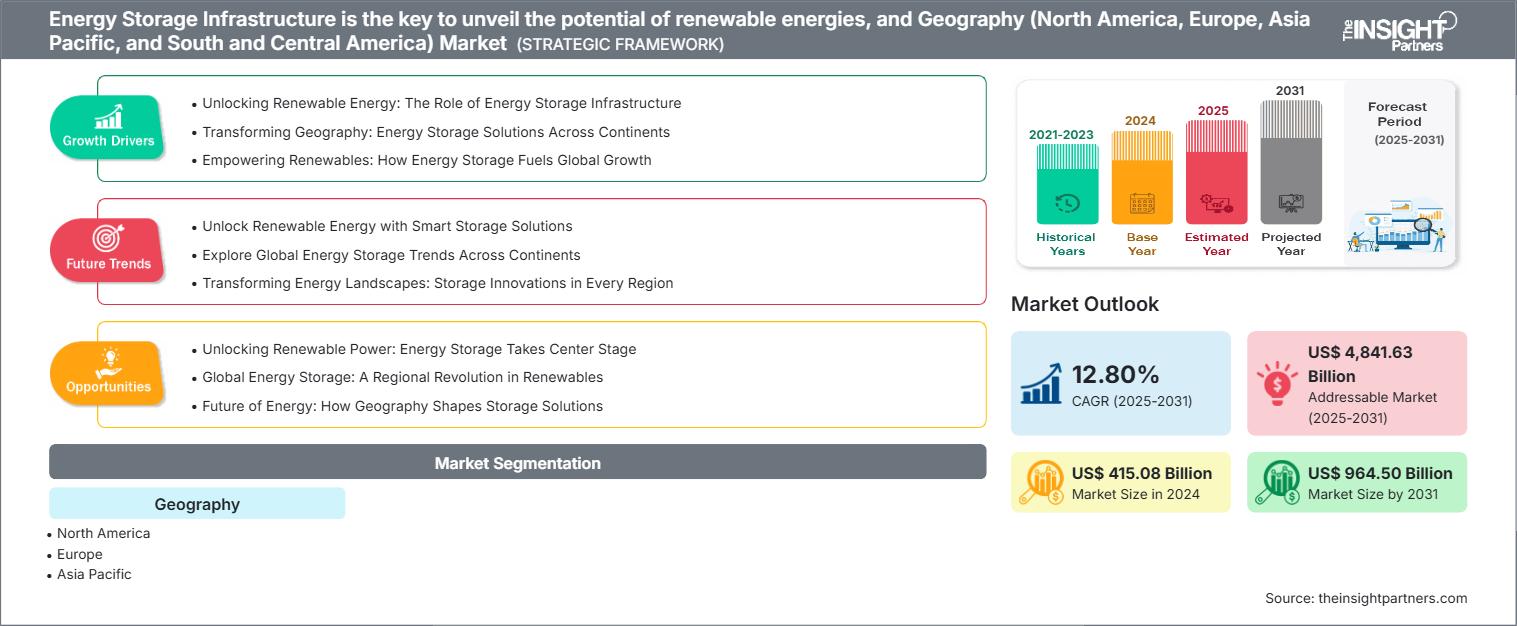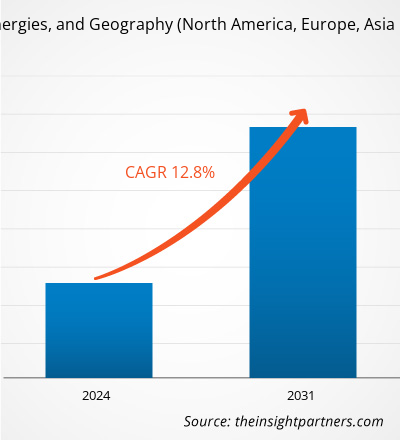من المتوقع أن يصل سوق البنية التحتية لتخزين الطاقة إلى 426.66 مليار دولار أمريكي بحلول عام 2031، ارتفاعًا من 256.39 مليار دولار أمريكي في عام 2021؛ ومن المتوقع أن ينمو بمعدل نمو سنوي مركب قدره 6.7% بين عامي 2021 و2031. أما من حيث السعة، فمن المتوقع أن يصل السوق إلى 11.30 ألف ميجاواط بحلول عام 2031، ارتفاعًا من 4.40 ألف ميجاواط في عام 2021، مسجلًا معدل نمو سنوي مركب مربحًا قدره 12.8% بين عامي 2021 و2031.
يمكن أن يُحدث دمج تقنيات تخزين الطاقة تحولاً جذرياً في كفاءة شبكة الكهرباء على المدى الطويل. ومن المتوقع أن تُسهم عوامل مثل الطفرة في توليد الطاقة من مصادر الطاقة المتجددة وزيادة الطلب على استقرار متطلبات الطاقة من شبكة الكهرباء بشكل كبير في نمو قطاع الطاقة. علاوة على ذلك، شجعت التطورات الحديثة في تقنيات تخزين الطاقة على تبني مصادر الطاقة المتجددة لدى مختلف المستخدمين النهائيين السكنيين والتجاريين حول العالم. ونتيجةً لذلك، اكتسب الاستثمار في تقنيات وبنية تخزين الطاقة التحتية، وخاصةً في تقنيات البطاريات، زخماً كبيراً بين كبار المستثمرين والهيئات الحكومية.
ستحصل على تخصيص لأي تقرير - مجانًا - بما في ذلك أجزاء من هذا التقرير، أو تحليل على مستوى الدولة، وحزمة بيانات Excel، بالإضافة إلى الاستفادة من العروض والخصومات الرائعة للشركات الناشئة والجامعات
البنية التحتية لتخزين الطاقة هي المفتاح للكشف عن إمكانات الطاقات المتجددة، والجغرافيا (أمريكا الشمالية، وأوروبا، ومنطقة آسيا والمحيط الهادئ، وأمريكا الجنوبية والوسطى) السوق: رؤى استراتيجية

- احصل على أهم اتجاهات السوق الرئيسية من هذا التقرير.ستتضمن هذه العينة المجانية تحليل البيانات، بدءًا من اتجاهات السوق وحتى التقديرات والتوقعات.
شهد سوق البنية التحتية لتخزين الطاقة تطورات ملحوظة خلال العقد الماضي، شملت تحديث التكنولوجيا وخفض الأسعار وتطبيق سياسات حكومية واستثمارات في البحث والتطوير في مجال تكنولوجيا التخزين. على سبيل المثال، انخفضت أسعار تقنيات البطاريات، التي ظلت أكثر تقنيات تخزين الطاقة شيوعًا عالميًا، بنسبة تتراوح بين 80% و85% تقريبًا خلال السنوات العشر الماضية. علاوة على ذلك، طورت العديد من الشركات الناشئة في مجال التكنولوجيا المبتكرة نماذج أولية واعدة لتقنيات تخزين طاقة ثورية محتملة. ومع ذلك، لا يزال تسويق تقنيات تخزين الطاقة لتلبية احتياجات التخزين القابلة للتوسع لفترات أطول يمثل تحديًا لجميع الجهات الفاعلة في السوق.شهدت عمليات الطرح والاستثمار في البحث والتطوير في تقنيات التخزين خلال العقد الماضي انخفاضًا حادًا. على سبيل المثال، انخفضت أسعار تقنيات البطاريات، التي ظلت أكثر تقنيات تخزين الطاقة شيوعًا عالميًا، بنسبة تقارب 80-85% خلال السنوات العشر الماضية. علاوة على ذلك، طورت العديد من الشركات الناشئة في مجال التقنيات المبتكرة نماذج أولية واعدة لتقنيات تخزين طاقة ثورية محتملة. ومع ذلك، لا يزال تسويق تقنيات تخزين الطاقة لتلبية احتياجات التخزين القابلة للتوسع لفترات أطول يمثل تحديًا لجميع الجهات الفاعلة في السوق.
يضم سوق البنية التحتية لتخزين الطاقة العديد من الشركات الرائدة عالميًا، إلى جانب شركات ناشئة متخصصة. ومع ذلك، تتمحور الكفاءات العامة لهذه الشركات بشكل رئيسي حول تقنية محددة، مثل التقنيات الميكانيكية والحرارية والكهروميكانيكية والكهرومغناطيسية والكيميائية وغيرها. وتُعد قابلية التوسع والجدوى التجارية لتقنيات تخزين الطاقة الجديدة مجالات التركيز الرئيسية، بالإضافة إلى التحديات القائمة التي تواجهها كل تقنية على حدة. ومن بين شركات تقنيات تخزين الطاقة الرائدة التي تهيمن حاليًا على السوق: ABB Ltd.، وTesla، وGeneral Electric، وSimmens، وLG Chem، وSunPower. الكهروميكانيكية ، والكهرومغناطيسية، والكيميائية، وغيرها من التقنيات. تُعدّ قابلية التوسع والجدوى التجارية لتقنيات تخزين الطاقة الجديدة من أهم مجالات التركيز، بالإضافة إلى التحديات القائمة التي تواجهها كل تقنية على حدة. ومن بين شركات تقنيات تخزين الطاقة الرائدة التي تهيمن حاليًا على السوق: ABB Ltd.، وTesla، وGeneral Electric، و Simmens ، وLG Chem، و SunPower .
تأثير جائحة كوفيد-19 على سوق البنية التحتية لتخزين الطاقة
أدت جائحة كوفيد-19 إلى اضطرابات في سلسلة التوريد والخدمات اللوجستية لقطاع الطاقة المتجددة، بما في ذلك قطاعات مثل الطاقة الشمسية وطاقة الرياح. وعلى عكس القطاعات الأخرى، لم تحصل قطاعات الطاقة المتجددة في مختلف البلدان على أي شكل من أشكال الإغاثة المالية أو المساعدة من حكوماتها خلال فترات الإغلاق الطويلة. ونتيجة لذلك، انخفض سوق تقنيات تخزين الطاقة أيضًا بسبب نقص الطلب من مواقع تركيب الطاقة المتجددة. بالإضافة إلى ذلك، انخفضت متطلبات الطاقة بشكل حاد خلال المراحل الأولى من الإغلاق. كما كان للقيود التي فرضتها الحكومات للسيطرة على انتشار كوفيد-19 تأثير سلبي عميق على الطلب على حلول تخزين الطاقة. علاوة على ذلك، أدى انخفاض التصنيع والإنتاج الصناعي إلى انخفاض مؤقت في الطلب على الكهرباء. كما فشلت العديد من الحكومات والشركات في تحقيق أهدافها السنوية للطاقة المتجددة خلال الوباء. وبالتالي، اضطرت العديد من الدول والمنظمات الدولية إلى تمديد المواعيد النهائية المحددة مسبقًا لتحقيق أهدافها وغاياتها المتعلقة بالطاقة المتجددة.فترات الإغلاق . ونتيجةً لذلك، تراجع سوق تقنيات تخزين الطاقة بشكل حاد نتيجةً لانخفاض الطلب من مواقع تركيب الطاقة المتجددة. إضافةً إلى ذلك، انخفضت متطلبات الطاقة بشكل حاد خلال المراحل الأولى من الإغلاق . كما كان للقيود التي فرضتها الحكومات للسيطرة على انتشار كوفيد-19 تأثير سلبي بالغ على الطلب على حلول تخزين الطاقة. علاوةً على ذلك، أدى تراجع التصنيع والإنتاج الصناعي إلى انخفاض مؤقت في الطلب على الكهرباء. كما فشلت العديد من الحكومات والشركات في تحقيق أهدافها السنوية المتعلقة بالطاقة المتجددة خلال الجائحة. وبالتالي، اضطرت العديد من الدول والمنظمات الدولية إلى تمديد المواعيد النهائية المحددة مسبقًا لتحقيق أهدافها وغاياتها المتعلقة بالطاقة المتجددة.
البنية التحتية لتخزين الطاقة: رؤى السوق
والتقدم التكنولوجي وتحسين التكلفة لدعم سوق البنية التحتية لتخزين الطاقة
على الرغم من أن تقنيات تخزين الطاقة موجودة عالميًا منذ أكثر من عقود، إلا أن شعبيتها وجدواها التجارية اكتسبتا زخمًا هائلًا بعد ظهور البطاريات كخيار شائع لتخزين الطاقة. علاوة على ذلك، ساهم الارتفاع الهائل في مبيعات المركبات الكهربائية بشكل كبير في تزايد الطلب على البنية التحتية لتخزين الطاقة القائمة على تكنولوجيا البطاريات. من ناحية أخرى، تكتسب الأهمية المتزايدة لتحديث الشبكة الكهربائية لتعزيز الأداء العام وكفاءة الشبكة الكهربائية بين المرافق العامة في الاقتصادات المتقدمة زخمًا متزايدًا. ونتيجةً لذلك، خصصت حكومات العديد من الدول برامج وأموالًا خاصة لتحديث مرافقها العامة بهدف بناء قدرات تخزين طاقة فائقة في السنوات القادمة. ومع استمرار الدول في تبني الطاقة المتجددة لتحقيق نمو مستدام في السنوات القادمة، من المتوقع أن تقود تكنولوجيا البطاريات تقنيات تخزين الطاقة. ولا تزال الحوافز المالية الجذابة والسياسات الحكومية، إلى جانب تكاليف إنتاج البطاريات التنافسية، تجذب استثمارات كبيرة إلى سوق البنية التحتية العالمية لتخزين الطاقة خلال فترة التوقعات. وفي الوقت نفسه، يستثمر عدد كبير من اللاعبين الرائدين في السوق في الصناعة، مثل Tesla وHitachi وReliance Industries، بشكل كبير في تطوير حلول تخزين الطاقة على نطاق واسع.
البنية التحتية لتخزين الطاقة هي المفتاح للكشف عن إمكانات الطاقات المتجددة، والرؤى الإقليمية للسوق (أمريكا الشمالية، وأوروبا، ومنطقة آسيا والمحيط الهادئ، وأمريكا الجنوبية والوسطى)
تُعدّ الاتجاهات والعوامل الإقليمية المؤثرة على البنية التحتية لتخزين الطاقة عاملاً أساسياً في إبراز إمكانات الطاقات المتجددة، وقد شرح محللو شركة "ذا إنسايت بارتنرز" السوقَ الجغرافية (أمريكا الشمالية، أوروبا، آسيا والمحيط الهادئ، وأمريكا الجنوبية والوسطى) بشكلٍ مُفصّل طوال فترة التوقعات. كما يناقش هذا القسم قطاعات السوق الجغرافية (أمريكا الشمالية، أوروبا، آسيا والمحيط الهادئ، وأمريكا الجنوبية والوسطى) ومناطقها الجغرافية في أمريكا الشمالية، أوروبا، آسيا والمحيط الهادئ، الشرق الأوسط وأفريقيا، وأمريكا الجنوبية والوسطى.
البنية التحتية لتخزين الطاقة هي المفتاح للكشف عن إمكانات الطاقات المتجددة، ونطاق تقرير السوق الجغرافي (أمريكا الشمالية وأوروبا وآسيا والمحيط الهادئ وأمريكا الجنوبية والوسطى)
| سمة التقرير | تفاصيل |
|---|---|
| حجم السوق في عام 2024 | 415.08 مليار دولار أمريكي |
| حجم السوق بحلول عام 2031 | 964.50 مليار دولار أمريكي |
| معدل النمو السنوي المركب العالمي (2025 - 2031) | 12.80% |
| البيانات التاريخية | 2021-2023 |
| فترة التنبؤ | 2025-2031 |
| المناطق والبلدان المغطاة | أمريكا الشمالية
|
| قادة السوق وملفات تعريف الشركات الرئيسية |
|
البنية التحتية لتخزين الطاقة هي المفتاح للكشف عن إمكانات الطاقات المتجددة، والجغرافيا (أمريكا الشمالية، وأوروبا، وآسيا والمحيط الهادئ، وأمريكا الجنوبية والوسطى)كثافة اللاعبين في السوق: فهم تأثيرها على ديناميكيات الأعمال
تُعدّ البنية التحتية لتخزين الطاقة مفتاحًا لاكتشاف إمكانات الطاقات المتجددة، ويشهد سوقها الجغرافي (أمريكا الشمالية، وأوروبا، وآسيا والمحيط الهادئ، وأمريكا الجنوبية والوسطى) نموًا سريعًا، مدفوعًا بتزايد طلب المستخدمين النهائيين نتيجةً لعوامل مثل تفضيلات المستهلكين المتطورة، والتقدم التكنولوجي، وزيادة الوعي بفوائد المنتج. ومع ازدياد الطلب، تعمل الشركات على توسيع عروضها، والابتكار لتلبية احتياجات المستهلكين، والاستفادة من الاتجاهات الناشئة، مما يُعزز نمو السوق.

- يعد الحصول على البنية التحتية لتخزين الطاقة هو المفتاح للكشف عن إمكانات الطاقات المتجددة، والجغرافيا (أمريكا الشمالية وأوروبا وآسيا والمحيط الهادئ وأمريكا الجنوبية والوسطى) نظرة عامة على أهم اللاعبين الرئيسيين في السوق
رؤى السوق القائمة على تقنية التخزين
يُقسّم سوق البنية التحتية العالمية لتخزين الطاقة، حسب نوعه، إلى ميكانيكية، وكهروميكانيكية، وكيميائية، وغيرها. وتشمل هذه الفئة تقنيات تخزين الطاقة الكهرومغناطيسية والحرارية. ورغم هيمنة التقنيات الميكانيكية القائمة على المضخات الهيدروليكية بشكل كبير على سوق البنية التحتية لتخزين الطاقة، إلا أن التقنيات الكهروميكانيكية القائمة على البطاريات حظيت باهتمام غير مسبوق من المستثمرين خلال العقد الماضي. علاوة على ذلك، ساهم تزايد شعبية المركبات الكهربائية في مضاعفة الطلب على حلول البنية التحتية لتخزين الطاقة القائمة على البطاريات في الاقتصادات المتقدمة والنامية.
يتبنى اللاعبون العاملون في سوق البنية التحتية لتخزين الطاقة استراتيجياتٍ مثل عمليات الدمج والاستحواذ ومبادرات السوق للحفاظ على مواقعهم في السوق. وفيما يلي بعض التطورات التي قام بها اللاعبون الرئيسيون:
- في يناير 2022، حصلت شركة هايدروستور، وهي شركة طاقة كندية، على تمويل يصل إلى 250 مليون دولار أمريكي من جولدمان ساكس، وهي شركة استثمارية رائدة، لتطوير مرافق تخزين طاقة الهواء المضغوط المتفوقة في جميع أنحاء الولايات المتحدة وأستراليا في السنوات القادمة.
- في أكتوبر 2021، أعلنت الحكومة الأمريكية عن خطتها لتمويل أبحاث تخزين الطاقة لتعزيز سلسلة توريد بطاريات الليثيوم. يركز البحث على ضمان توافر بطاريات السيارات الكهربائية، إلى جانب تعزيز كفاءة البنية التحتية الحالية لتخزين الطاقة. كما أعلنت وزارة الطاقة الأمريكية عن خططها لإقامة شراكات بين القطاعين العام والخاص لسد الثغرات في سلسلة توريد بطاريات الليثيوم داخل البلاد.
يتم تقسيم سوق البنية التحتية لتخزين الطاقة على أساس تكنولوجيا التخزين والجغرافيا. بناءً على تكنولوجيا التخزين، يتم تقسيم السوق إلى ميكانيكية وكهروميكانيكية وكيميائية وغيرها. من الناحية الجغرافية، يتم تقسيم سوق البنية التحتية لتخزين الطاقة إلى خمس مناطق رئيسية أمريكا الشمالية (الولايات المتحدة وكندا) وأوروبا (المملكة المتحدة وألمانيا وفرنسا) وآسيا (الصين واليابان والهند) والشرق الأوسط (المملكة العربية السعودية والإمارات العربية المتحدة) وبقية العالم. من حيث السعة، من المتوقع أن تستمر الصين في الهيمنة على سوق البنية التحتية لتخزين الطاقة خلال الفترة 2022-2031، بعد الاستثمارات الضخمة في تشجيع اعتماد الطاقة المتجددة من قبل الحكومة المركزية. من حيث الموقع التنافسي، تواصل العديد من شركات التكنولوجيا الرائدة، بالإضافة إلى الشركات الناشئة المبتكرة المتخصصة، الهيمنة على سوق البنية التحتية لتخزين الطاقة العالمية بعروض أعمالها. يقدم التقرير لمحة موجزة عن أدائهم، إلى جانب تطوراتهم الرئيسية. ومن بين الشركات التي تم عرضها في دراسة سوق البنية التحتية لتخزين الطاقة شركة ABB Ltd؛ وشركة Tesla Inc.؛ وشركة LG Chem Ltd.؛ وشركة Hitachi Energy Ltd.؛ شركة توشيبا للبنية التحتية وأنظمة الحلول؛ وشركة باناسونيك؛ وشركة BYD المحدودة؛ وشركة سامسونج SDI المحدودة؛ وشركة EcoFLow؛ وشركة Sonnen GmbH.
- التحليل التاريخي (سنتان)، سنة الأساس، التوقعات (7 سنوات) مع معدل النمو السنوي المركب
- تحليل PEST و SWOT
- حجم السوق والقيمة / الحجم - عالمي، إقليمي، بلد
- الصناعة والمنافسة
- مجموعة بيانات إكسل
التقارير الحديثة
شهادات العملاء
سبب الشراء
- اتخاذ قرارات مدروسة
- فهم ديناميكيات السوق
- تحليل المنافسة
- رؤى العملاء
- توقعات السوق
- تخفيف المخاطر
- التخطيط الاستراتيجي
- مبررات الاستثمار
- تحديد الأسواق الناشئة
- تحسين استراتيجيات التسويق
- تعزيز الكفاءة التشغيلية
- مواكبة التوجهات التنظيمية






















 احصل على عينة مجانية ل - البنية التحتية لتخزين الطاقة هي المفتاح لكشف إمكانات الطاقات المتجددة، والجغرافيا (أمريكا الشمالية، وأوروبا، ومنطقة آسيا والمحيط الهادئ، وأمريكا الجنوبية والوسطى)
احصل على عينة مجانية ل - البنية التحتية لتخزين الطاقة هي المفتاح لكشف إمكانات الطاقات المتجددة، والجغرافيا (أمريكا الشمالية، وأوروبا، ومنطقة آسيا والمحيط الهادئ، وأمريكا الجنوبية والوسطى)